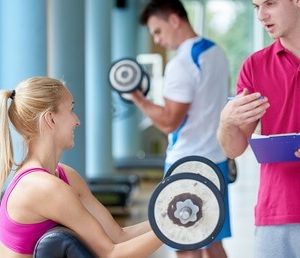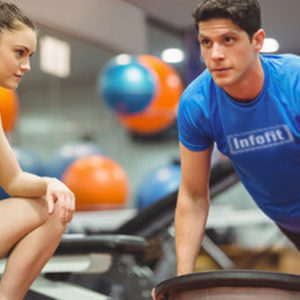Direct Effects of Static & Dynamic Stretching
One of the biggest mistakes people make when they first start working out is underestimating the value of stretching. Stretching may not seem nearly as important as strength training or cardio, but it’s actually vital for boosting your strength, power, and performance, preventing injury, and more.
Warming up with some stretches before your workout prepares your body for physical activity, while post-workout stretching maximizes results and speeds recovery. Whether you’re training for an event or working out for overall health and fitness, stretching should be a key part of your routine.
That being said, there’s more than one type of stretching, and they each produce different results. The type of stretching you do and when will have a major impact on your results. In general, stretching will elongate your muscles and improve your flexibility, but which type of stretching should you be doing to build muscle strength and power?
You might be surprised to hear that the direct effects of static and dynamic stretching are a topic of hot debate among fitness experts. Let’s explore the benefits and differences between the two and how they can help you build muscle strength and power.
What is Static Stretching?
Even if you’re brand new to working out, you’ve probably done static stretching at one time or another, such as in gym class when you were in school. The technique involves extending a muscle and holding the stretch for around thirty seconds, rinse and repeat a few times until the muscle feels loose.
Static stretching is meant to release tension in the muscles and improve flexibility, which lowers the risks of injuries like pulled, strained, or sprained muscles.
How is Dynamic Stretching Different?
Dynamic stretching also increases the range of motion and flexibility in your muscles, preparing your body for exercise. But that’s where the similarities end. While static stretching requires you to hold the stretch for an extended length of time, dynamic stretching does not.
The primary goal of dynamic stretching is to keep the body in motion. Dynamic stretches get the entire body moving and involved in the stretch. Unlike passive static stretching, dynamic stretching is active stretching involving the movement of the muscles and joints through their full range of motion.
Static Stretching vs Dynamic Stretching: Which One to Do When?
Static stretching used to be the go-to type of stretching for warming up before a workout. However, opinions have changed, and research shows that static stretching prior to exercise can actually reduce muscle strength and have a negative impact on performance.
While static stretching does improve your range of motion and flexibility, it can have a major impact on how you perform during your workout.
It’s best to save static stretching for after your workout because it also helps the muscles cool down by relieving tension and helping them relax. It also improves circulation and increases blood flow to the muscles, helping them recover faster and better, which also builds muscle strength over time.
On the other hand, dynamic stretching before your workout can actually boost your performance, helping you build muscle strength and power with each workout. Active warmups, including dynamic stretching, have been shown to increase strength and power during exercise as well.
In fact, dynamic stretching is a fantastic way to improve your overall performance and reduce your risk of injury when performed before a workout. Since dynamic stretching is active, it also raises your core body temperature, making it ideal for warming up before a workout.
Avoid Bouncing or Ballistic Motions When Stretching
No matter which type of stretching you’re doing, don’t make the mistake of incorporating bouncing or ballistic motions into your stretches. Both types of stretching should be done in a controlled manner to reduce the risk of injury. Uncontrolled movement is a sure way to strain or pull a muscle, which could disrupt your fitness routine for several weeks.
More Reasons to Prioritize Stretching Before and After Your Workout
- Long Term Benefits
We’ve already mentioned that stretching improves flexibility and range of motion, but the benefits don’t have to end shortly after your workout. By prioritizing stretching on a regular basis, you can actually lengthen and strengthen your muscles, achieving results that last for the long term.
- Improved Female Fertility
Fertility experts at the Brooklyn clinic, Yinova Center, recommend static stretching to their female fertility patients because it can reduce stress and anxiety while helping to tone and align the uterus for increased chances of conception. Hip opening stretches also help to strengthen those all-important pelvic floor muscles which can give your sex life a boost and help you out later on during labor and delivery.
- Makes Daily Activities Easier
Increasing your muscle strength and power doesn’t just benefit your workouts, it can also make daily activities easier. Many daily tasks involve stretching, flexibility, and muscle strength, such as squatting to get in or out of a chair or bending down to pick up your child.
- Helps You Pinpoint Imbalances
Stretching is a great way to pinpoint imbalances in strength and flexibility in certain muscles groups. This allows you to correct the imbalances by strengthening the weaker areas. For example, you may notice that you are able to sink deeper into a lunge stretch on your right side compared to your left.
That observation alerts you to weaknesses in the left hip and muscles of your left leg which could also be affecting your workout performance. Now you can pay more attention to working your legs and hips evenly, taking special care to work the left leg through its full range of motion.
- Improve the Mind-Muscle Connection
Performing dynamic stretches before your workout fires up the mind-muscle connection. This improves efficiency during your workout because you can activate the muscles just by thinking about them as you move. For example, when you’re doing deadlifts, a solid mind-muscle connection helps you engage your glutes and hamstrings instead of your lower back.
Wrapping Things Up
No one type of stretching is better than the other, and most experts recommend including a variety of both types in your routine. Each one provides specific benefits and utilizing them at the right time can provide valuable results.
Dynamic stretching is better suited to warming up before your workout, while static stretching is ideal for cooling down afterward. By combining both methods, you can put your body in a better position to build muscle strength and power, perform at your best, increase your flexibility, and lower your risk of injury.
Author
Nicole McCray
Nicole is an experienced content writer with a passion for all aspects of wellness. She worked a side gig at a yoga studio for years before becoming a mom, and absolutely fell in love with holistic and alternative therapies during her first pregnancy. She’s been proclaimed the “health nut” amongst family and friends, and when she’s not writing, Nicole can be found studying to become a health coach and reading up on all aspects of healthy living.
-
 Family Personal Training$152.25
Family Personal Training$152.25 -
 1 on 1 Personal Training$99.75 – $1,575.00
1 on 1 Personal Training$99.75 – $1,575.00 -
 Personal Training Certification
Personal Training Certification

